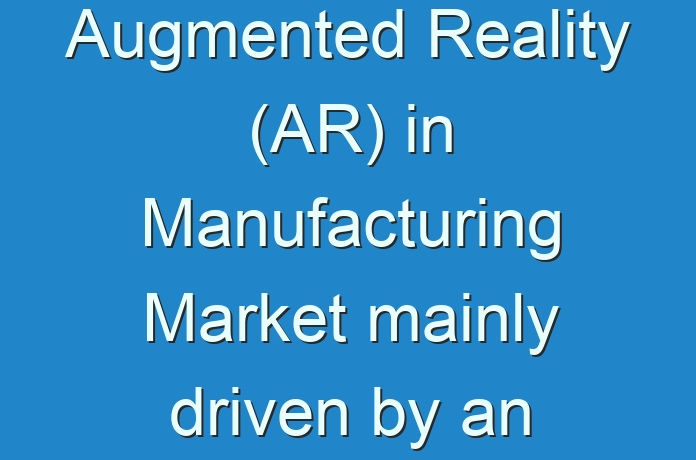
Augmented reality (AR) is a term used to identify a set of technologies that allow the view of the real world environment to be augmented or enhanced by computer-generated elements or objects. The visual perception of elements in the physical environment is enhanced through the use of computing devices. An emerging area of AR applications is the manufacturing industry, which is concerned with the process of transforming raw materials into finished goods with added value. Manufacturing companies need real-time information exchanges at various stages of the product lifecycle such as design, prototyping, production, assembly, maintenance/repair, etc.. This is due to rapid globalization and increase in the complexity of internal processes and supply chains. In this scenario, AR can be of great help because of its capability to simulate, assist, and improve the processes before they are carried out. The customers of manufacturing and industrial enterprises are open to utilizing augmented reality (AR) value-add services to reduce downtime and further streamline their operations.
Manufacturing enterprises are using augmented reality in various applications. The technology is being used in assistive systems that provide complex assembly instructions using head-mounted displays (HMDs). Augmented reality is also used in the training and development of workers to address an acute skill gap by proving expert assistance and support in manufacturing operations through telepresence solutions. Moreover, the technology is used in safety inspection and error detection and comprehensive quality assurance checks. For instance, AR is used in Porshe’s quality assurance processes for its car manufacturing plant. AR can be used in quality assurance in order to perform real-time analysis of parts and assembled components, leading to the possibility of the automation of QA processes.
PreBook Now:
https://www.transparencymarketresearch.com/checkout.php?rep_id=55272<ype=S
The augmented reality in the manufacturing market is primarily driven by an increase in the development and adoption of AR capable wearables and systems such as Microsoft’s Hololens and the Oculus Rift. These products are capable of running on portable general purpose devices such as tablets or smartphones and dedicated hardware such as smart glasses and head mounted displays.
Augment reality devices have been known to be used in the manufacturing processes of major players such as Boeing. Companies use AR technology for improving their wire assembly process with AR headsets, which allow employees to issue voice commands conveniently and view information quickly. Using AR devices has reduced Boeing’s wire assembly process time by 25% and has lowered errors to nearly 0%. Ford notably has used the Microsoft HoloLens AR headset in order to overhaul its design process, which has allowed the company’s designers to be more creative, collaborate better, improve decision making, as well as work quicker.
Request for a sample:
https://www.transparencymarketresearch.com/sample/sample.php?flag=S&rep_id=55272
The application of augmented reality devices in the manufacturing sector has faced certain bottlenecks such as complexity in the development of AR algorithms, portability issues due to the size of devices, limited computing capacities of devices, power requirements, and the deployment of hardware on a large scale. The reduced portability of AR devices raise concerns over the long-term use of such devices, which have been reported to cause stress and strain to users. These factors are likely to restrain the market.
The augmented reality in the manufacturing market can be segmented based on component, application, and region. Based on component, the market can be classified into hardware and software. The hardware segment can be further divided into smart glasses and head mounted displays (HMDs). The software segment can be divided into AR development toolkits and AR content management systems. In terms of application, the market can be segmented into product design, product assembly, training & development, inspections and quality control (QC). The product assembly segment can be further categorized into assembly planning, assembly training, and assembly simulation. The inspections segment can be further categorized into facility inspection and process inspection.
Ask for brochure:
https://www.transparencymarketresearch.com/sample/sample.php?flag=B&rep_id=55272
In terms of region, the augmented reality in the manufacturing market can be segmented into North America, Europe, Asia Pacific, Middle East and Africa and South America. The augmented reality in the manufacturing market in Asia Pacific is expected to expand at a rapid rate during the forecast period, due to rapid expansion in the manufacturing industries across developing economies such as India and China. The market in China is likely to be propelled by large investments in manufacturing operations for developing latest technological devices such as smart glasses. Presence of major players such as Samsung Electronics and Seiko Epson Corporation is expected to positively affect the market in China, Japan, and South Korea.
Major vendors providing AR Solutions are Atheer Inc., EON Reality Inc., Eonite Perception Inc., Marxent Labs LLC, Kaon Interactive Inc., and VividWorks Oy.
Read Our Latest Press Release:





